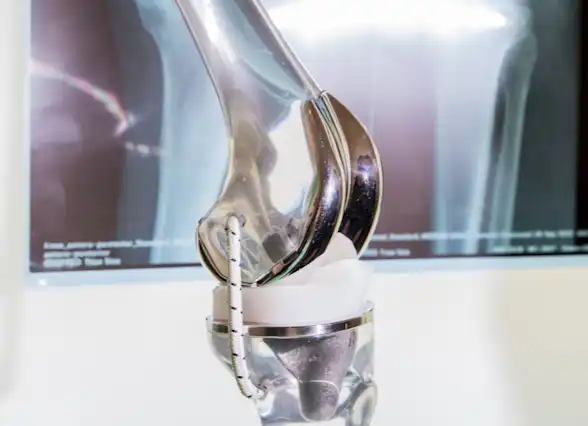What is Knee Arthroplasty (Replacement)?
We hear the term "knee replacement" a lot in relation to older adults, but what is it, what does it mean, and when is it needed?
Get insurance benefits, legal documents, and medical records in one place

Helpful Highlights
Arthroplasty is the medical term for joint replacement.
There are two types of knee replacements - total and partial.
There are two ways to attach knee replacements - press-fit and cemented.
An orthopedic surgeon performs the knee replacement and will have many recommendations, including delaying surgery when warranted.
Long considered the “gold standard” operation for knee arthritis, total knee arthroplasty (TKA or total knee replacement) is still by far the most commonly performed joint replacement procedure.
Knee replacement is most suitable for middle-aged and older people (generally 50 and over) who have arthritis in more than one compartment of the knee and who do not intend to return to high-impact athletics or heavy labor.
What is the knee?
The knee is the largest joint in the body - a hinge joint - that consists of the lower end of the femur (thigh bone), the top end of the tibia (shin bone), and the patella (knee cap). Note that the fibula, the smaller bone in the lower leg, is not part of the knee joint.
What is TKA - Total knee arthroplasty?
Total knee arthroplasty (TKA), also referred to as total knee replacement, is one of the most common surgical procedures performed for severe arthritis of the knee, intended to relieve pain and disability in the joint. This surgery is more accurately described as a knee "resurfacing" because only the surface of the bones is replaced. Metal alloy and medical-grade plastic parts are used to cap the ends of the bones that form the knee joint, along with the underside of the kneecap.
This surgery may be considered for someone who has severe arthritis, a severe knee injury, or joint deformities causing bowlegs for whom less invasive therapies are not working (see below). Normally, this surgery is done for people between the ages of 50-80 years but can occur for younger people as well.
Less invasive therapies are often implemented before considering knee replacement surgery:
Anti-inflammatory medications (whether steroidal or non-steroidal)
Glucosamine and chondroitin sulfate
Pain medications (whether opioid or non-opioid)
Limiting painful activities
Assistive devices for walking (such as a cane or walker)
Physical therapy
Cortisone injections into the knee joint (a steroid)
Viscosupplementation injections (to add lubrication into the joint to make joint movement less painful)
Weight loss (for obese persons)
Results of this procedure generally are excellent with 90-95% of total knee replacements continuing to function beyond 10 years after surgery. Most people walk without any aid, most can do stairs and rise from sitting with no trouble, and most resume their desired level of recreational activity.
Types of knee arthroplasty (replacement)
Broadly speaking, there are two types of knee replacements. Both have long histories and good clinical results.
Total knee replacements
Partial knee replacements (minimally invasive, often called "mini knee")
Types of implant attachments
A press-fit (uncemented) prosthesis attaches with an advanced material of rough, porous surface that encourages new bone growth. The new bone grows into the spaces in the implant, holding it in place without the need for cement.
A cemented prosthesis attaches with bone cement.
Both press fit and cemented approaches work well to secure the implant. As knee replacement techniques have evolved over the years, the cement composition has improved, as have methods to encourage natural bone regrowth.
For some knee replacements, the surgeon will combine methods.
The surgeon who performs knee arthroplasty (replacement)
If a knee replacement is the best treatment, your loved one's healthcare provider will send them to an orthopedic surgeon for evaluation. Again, this surgery is usually performed on adults after other therapies like walking aids, weight loss, medicines, and physical therapy have failed to make a difference.
There are various surgical approaches to knee replacement surgery, including minimally invasive options that may be appropriate for some people.
Recovery and rehabilitation after surgery are essential to restore mobility and functionality and return to activities with less pain.
Because all surgeries have risks, and prostheses can fail as time goes by, the surgeon may recommend delaying a knee replacement until more severe symptoms are present.
RESOURCES
American Academy of Orthopaedic Surgeons (AAOS) – Total Knee Replacement
American Association of Hip & Knee Surgeons (AAHKS) – Total Knee Replacement
Johns Hopkins Medicine – Knee Replacement Surgery
Mayo Clinic – Knee Replacement
No content in this app, regardless of date, should ever be used as a substitute for direct medical advice from your doctor or other qualified clinician.
Get more support and guidance on insurance benefits, medical records and legal forms.
Helpful brings together your insurance benefits, legal documents, and medical records in one personalized place — so you always know what you have, and never have to search again.

Technology for Health Tasks. Mental Health for the Tough Stuff.
Helpful connects your medical records, insurance, and caregiving tasks automatically. And when you need more than logistics, a therapist is here to guide you.
In-Network and Covered
For Individuals, Couples and Families
HIPAA Compliant, Data Stays Private


Healthcare Tasks Simplified

From syncing records to spotting drug interactions, Helpful does the heavy lifting, turning complex health info into clear tasks and showing you benefits you can actually use, giving you clarity and control over your care.

In-Network Mental Health

Our licensed therapists are here to support you and your loved ones through stress, burnout, and life’s hardest moments, with an inclusive, compassionate approach that works with most insurance plans.

Create Legal Documents

Plan ahead by creating will, trusts, advance directives and more, that ensure your wishes are honored in the event you can’t speak for yourself -with Helpful guiding you every step of the way.